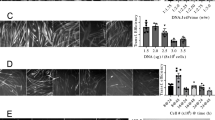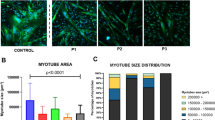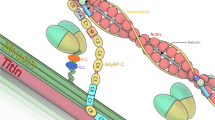Abstract
The development of skeletal muscle requires progression of a highly ordered cascade of events comprising myogenic lineage commitment, myoblast proliferation, and terminal differentiation. The process of myogenesis is controlled by several myogenic transcription factors that act as terminal effectors of signaling cascades and produce appropriate developmental stage-specific transcripts. PHD finger protein 20 (PHF20) is a multidomain protein and subunit of a lysine acetyltransferase complex that acetylates histone H4 and p53, but its function is unclear. Notably, it has been reported that PHF20 knockout mice die shortly after birth and display a wide variety of phenotypes within the skeletal and hematopoietic systems. Therefore, the putative role of PHF20 in myogenic differentiation was further investigated. In the present study, we found that protein and mRNA expression levels of PHF20 were decreased during myogenic differentiation in C2C12 cells. At the same time, Yin Yang 1 (YY1) was also decreased during myogenic differentiation. PHF20 overexpression increased YY1 expression during myogenic differentiation, together with a delay in MyoD expression. PHF20 expression enhanced the transcriptional activity of YY1 while shRNA-mediated depletion of PHF20 resulted in the reduction of YY1 promoter activity in C2C12 cells. In addition, PHF20 directly bounds to the YY1 promoter in C2C12 cells. In a similar manner, YY1 expression was elevated while myosin heavy chain expression was decreased in PHF20 transgenic (TG) mice. Histological analysis revealed abnormalities in the shape and length of muscles in PHF20-TG mice. Furthermore, PHF20-TG muscles slowly regenerated after cardiotoxin injection, indicating that PHF20 affected muscle differentiation and regeneration after injury in vivo. Taken together, these results suggested that PHF20 plays an important role in myogenic differentiation by regulating YY1.
Similar content being viewed by others
Log in or create a free account to read this content
Gain free access to this article, as well as selected content from this journal and more on nature.com
or
References
Cui G, Park S, Badeaux AI, Kim D, Lee J, Thompson JR, et al. PHF20 is an effector protein of p53 double lysine methylation that stabilizes and activates p53. Nat Struct Mol Biol. 2012;19:916–24.
Zhao W, Li Q, Ayers S, Gu Y, Shi Z, Zhu Q, et al. Jmjd3 inhibits reprogramming by upregulating expression of INK4a/Arf and targeting PHF20 for ubiquitination. Cell. 2013;152:1037–50.
Badeaux AI, Yang Y, Cardenas K, Vemulapalli V, Chen K, Kusewitt D, et al. Loss of the methyl lysine effector protein PHF20 impacts the expression of genes regulated by the lysine acetyltransferase MOF. J Biol Chem. 2012;287:429–37.
Sanchez AM, Candau RB, Bernardi H. FoxO transcription factors: their roles in the maintenance of skeletal muscle homeostasis. Cell Mol Life Sci. 2014;71:1657–71.
Wu AL, Kim JH, Zhang C, Unterman TG, Chen J. Forkhead box protein O1 negatively regulates skeletal myocyte differentiation through degradation of mammalian target of rapamycin pathway components. Endocrinology. 2008;149:1407–14.
Knight JD, Kothary R. The myogenic kinome: protein kinases critical to mammalian skeletal myogenesis. Skelet Muscle. 2011;1:29.
Zhou L, Sun K, Zhao Y, Zhang S, Wang X, Li Y, et al. Linc-YY1 promotes myogenic differentiation and muscle regeneration through an interaction with the transcription factor YY1. Nat Commun. 2015;6:10026.
Blattler SM, Cunningham JT, Verdeguer F, Chim H, Haas W, Liu H, et al. Yin Yang 1 deficiency in skeletal muscle protects against rapamycin-induced diabetic-like symptoms through activation of insulin/IGF signaling. Cell Metab. 2012;15:505–17.
Cunningham JT, Rodgers JT, Arlow DH, Vazquez F, Mootha VK, Puigserver P. mTOR controls mitochondrial oxidative function through a YY1-PGC-1alpha transcriptional complex. Nature. 2007;450:736–40.
Ji K, Zheng J, Lv J, Xu J, Ji X, Luo YB, et al. Skeletal muscle increases FGF21 expression in mitochondrial disorders to compensate for energy metabolic insufficiency by activating the mTOR-YY1-PGC1alpha pathway. Free Radic Biol Med. 2015;84:161–70.
Tran Q, Jung JH, Park J, Lee H, Hong Y, Cho H, et al. S6 kinase 1 plays a key role in mitochondrial morphology and cellular energy flow. Cell Signal. 2018;48:13–24.
Jin M, Hong Y, Lee H, Tran Q, Cho H, Kim M, et al. 1,2-Dichloropropane (1,2-DCP)-induced angiogenesis in dermatitis. Toxicol Res. 2019;35:361–9.
Garry GA, Antony ML, Garry DJ. Cardiotoxin Induced Injury and skeletal muscle regeneration. Methods Mol Biol. 2016;1460:61–71.
Zhang T, Park KA, Li Y, Byun HS, Jeon J, Lee Y, et al. PHF20 regulates NF-kappaB signalling by disrupting recruitment of PP2A to p65. Nat Commun. 2013;4:2062.
Lee TC, Shi Y, Schwartz RJ. Displacement of BrdUrd-induced YY1 by serum response factor activates skeletal alpha-actin transcription in embryonic myoblasts. Proc Natl Acad Sci USA. 1992;89:9814–8.
Vincent CK, Gualberto A, Patel CV, Walsh K. Different regulatory sequences control creatine kinase-M gene expression in directly injected skeletal and cardiac muscle. Mol Cell Biol. 1993;13:1264–72.
Klein BJ, Wang X, Cui G, Yuan C, Botuyan MV, Lin K, et al. PHF20 readers link methylation of histone H3K4 and p53 with H4K16 acetylation. Cell Rep. 2016;17:1158–70.
Chinnappan D, Xiao D, Ratnasari A, Andry C, King TC, Weber HC. Transcription factor YY1 expression in human gastrointestinal cancer cells. Int J Oncol. 2009;34:1417–23.
Fischer U, Struss AK, Hemmer D, Pallasch CP, Steudel WI, Meese E. Glioma-expressed antigen 2 (GLEA2): a novel protein that can elicit immune responses in glioblastoma patients and some controls. Clin Exp Immunol. 2001;126:206–13.
Pallasch CP, Struss AK, Munnia A, Konig J, Steudel WI, Fischer U, et al. Autoantibodies against GLEA2 and PHF3 in glioblastoma: tumor-associated autoantibodies correlated with prolonged survival. Int J Cancer. 2005;117:456–9.
Yang JW, Jeong BC, Park J, Koh JT. PHF20 positively regulates osteoblast differentiation via increasing the expression and activation of Runx2 with enrichment of H3K4me3. Sci Rep. 2017;7:8060.
Zhang C, Gao W, Dong S, Chen G, Han R, Wen S, et al. [The expression and clinical significance of Bax and PHF20 in laryngeal squamous cell carcinoma]. Lin Chung Er Bi Yan Hou Tou Jing Wai Ke Za Zhi = J Clin Otorhinolaryngol, Head, Neck Surg. 2015;29:1701–5.
Xun J, Wang D, Shen L, Gong J, Gao R, Du L, et al. JMJD3 suppresses stem cell-like characteristics in breast cancer cells by downregulation of Oct4 independently of its demethylase activity. Oncotarget. 2017;8:21918–29.
Langen RC, Van Der Velden JL, Schols AM, Kelders MC, Wouters EF, Janssen-Heininger YM. Tumor necrosis factor-alpha inhibits myogenic differentiation through MyoD protein destabilization. FASEB J: Off Publ Federation Am Societies Exp Biol. 2004;18:227–37.
Zhu X, Li M, Jia X, Hou W, Yang J, Zhao H, et al. The homeoprotein Msx1 cooperates with Pkn1 to prevent terminal differentiation in myogenic precursor cells. Biochimie. 2019;162:55–65.
Kim SH, Yi SJ, Lee H, Kim JH, Oh MJ, Song EJ, et al. beta2-Adrenergic receptor (beta2-AR) agonist formoterol suppresses differentiation of L6 myogenic cells by blocking PI3K-AKT pathway. Anim cells Syst. 2019;23:18–25.
Liu D, Li S, Cui Y, Tong H, Li S, Yan Y. Podocan affects C2C12 myogenic differentiation by enhancing Wnt/beta-catenin signaling. J Cell Physiol. 2019;234:11130–9.
Acknowledgements
This work was financially supported by research fund of Chungnam National University (Jongsun Park) and the National Research Foundation of Korea (NRF) grant funded by the Korea Government (MEST) (NRF-2014R1A1A3050752, NRF-2015R1A2A2 A01003597). The English in this document has been checked by at least two professional editors, both native speakers of English. For a certificate, please see: http://www.textcheck.com/certificate/KMV0G8.
Author information
Authors and Affiliations
Corresponding authors
Ethics declarations
Conflict of interest
The authors declare that they have no conflict of interest.
Additional information
Publisher’s note Springer Nature remains neutral with regard to jurisdictional claims in published maps and institutional affiliations.
Edited by R. Kitsis
Supplementary information
Rights and permissions
About this article
Cite this article
Lee, H., Hong, Y., Kong, G. et al. Yin Yang 1 is required for PHD finger protein 20-mediated myogenic differentiation in vitro and in vivo. Cell Death Differ 27, 3321–3336 (2020). https://doi.org/10.1038/s41418-020-0580-6
Received:
Revised:
Accepted:
Published:
Issue date:
DOI: https://doi.org/10.1038/s41418-020-0580-6
This article is cited by
-
Admixture and selection offer insights for the conservation and breeding of Guyuan cattle
BMC Biology (2025)
-
Exploring the various functions of PHD finger protein 20: beyond the unknown
Toxicological Research (2025)
-
Enhancement of renal fibrosis in PHF20 transgenic mice
Toxicological Research (2025)
-
Redressing the interactions between stem cells and immune system in tissue regeneration
Biology Direct (2021)



